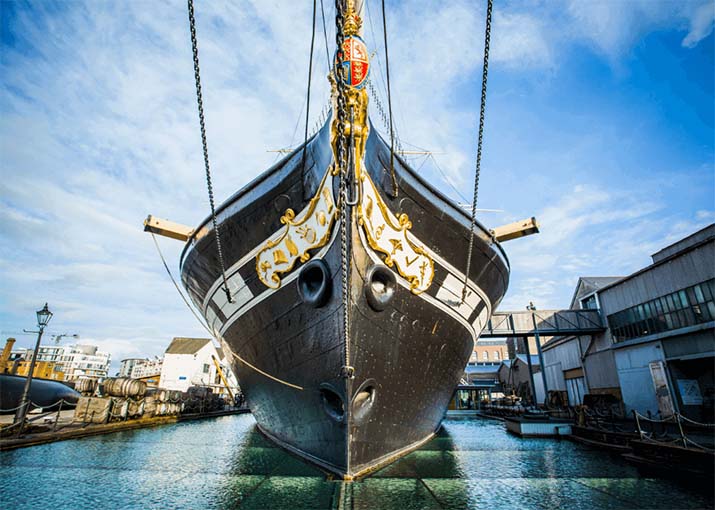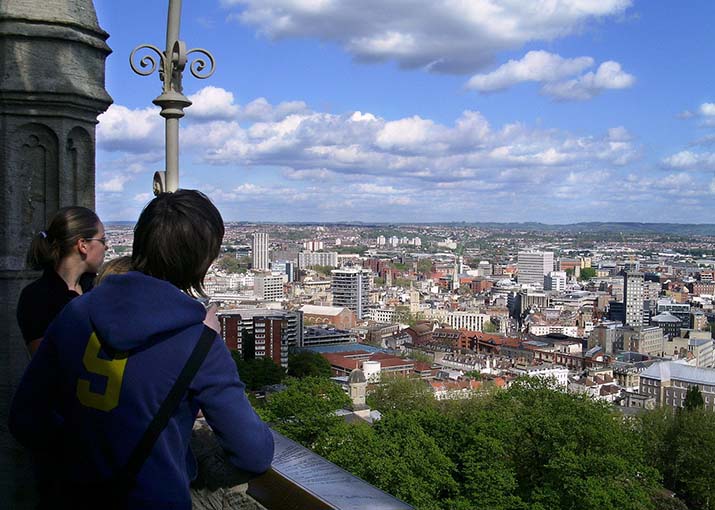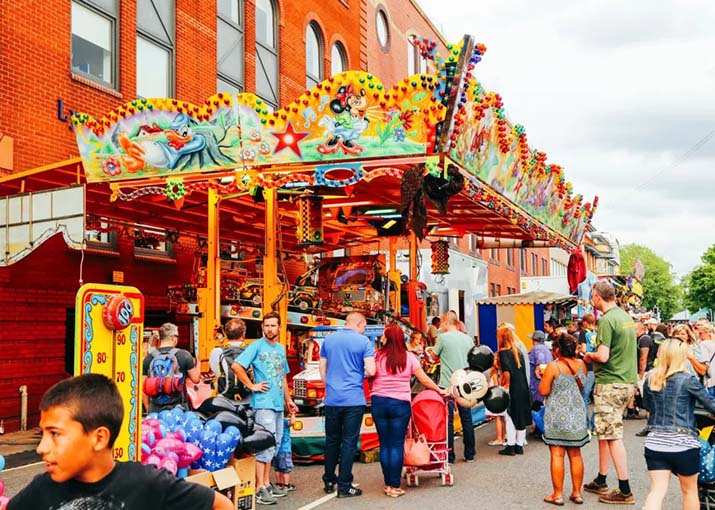Bristol, a city steeped in history and bursting with creativity, offers an eclectic mix of experiences for travelers. From historic landmarks and cultural hubs to scenic vistas and unique attractions, Bristol has something for everyone.
1. Clifton Suspension Bridge: An Iconic Engineering Marvel
Location: Clifton, Bristol BS8 3PA, United Kingdom
How to Get There: The bridge is easily accessible by bus from the city center. Bus numbers 8 and 9 run frequently from Temple Meads Station and Bristol City Centre to Clifton Village. Alternatively, you can take a scenic walk from the city center, which takes about 30 minutes.
Ticket Prices: Access to the bridge is free for pedestrians and cyclists. Car tolls are £1 each way.
Discounts and Deals: The Clifton Suspension Bridge Trust occasionally offers guided tours at discounted rates. Check their official website for the latest offers.
Recommendation Rating: 5/5
The Clifton Suspension Bridge is undoubtedly one of Bristol’s most iconic landmarks. Designed by the famous engineer Isambard Kingdom Brunel, this impressive structure spans the picturesque Avon Gorge and has become a symbol of the city. As I approached the bridge, the sight of its towering ironwork against the backdrop of the gorge was simply breathtaking.
I started my journey from the city center, opting for a leisurely walk through Clifton Village. The village itself is charming, with its boutique shops, quaint cafes, and Georgian architecture. As I neared the bridge, I could see why it has captivated the imaginations of so many visitors.
Walking across the bridge, I was struck by the stunning views of the Avon Gorge and the city beyond. The walkway is wide enough for pedestrians and cyclists to comfortably share, and there are several viewing points where you can stop and take in the scenery. I spent a good amount of time at these vantage points, capturing photos and simply soaking in the beauty of the surroundings.
One of the highlights of my visit was joining a guided tour offered by the Clifton Suspension Bridge Trust. For a modest fee, the tour provided fascinating insights into the bridge’s history and construction. Our guide was knowledgeable and passionate, sharing stories about Brunel’s vision and the challenges faced during the bridge’s construction. I highly recommend taking this tour if you have the time.
Whether you’re an engineering enthusiast or simply looking for a scenic spot to enjoy the views, the Clifton Suspension Bridge is a must-visit. The combination of its historical significance and natural beauty makes it a standout attraction in Bristol.
2. SS Great Britain: Step Back in Maritime History
Location: Great Western Dockyard, Gas Ferry Rd, Bristol BS1 6TY, United Kingdom
How to Get There: The SS Great Britain is located on the Harbourside and can be reached by bus, ferry, or on foot. Buses 506 and 73 stop nearby, and the Bristol Ferry Boats provide a scenic route from various points along the harbor. It’s also a pleasant 20-minute walk from the city center.

Ticket Prices: Adults: £18.00, Children (5-16): £11.00, Family (2 adults + 2 children): £49.00. Prices include unlimited re-entry for a year.
Discounts and Deals: Discounted tickets are available for students, seniors, and groups. Check the SS Great Britain official website for special promotions and online discounts.
Recommendation Rating: 5/5
The SS Great Britain, a marvel of Victorian engineering, offers a fascinating journey back in time. Designed by Isambard Kingdom Brunel, this historic ship was the longest passenger ship in the world when it was launched in 1843. Today, it sits proudly in the Great Western Dockyard, offering visitors a glimpse into maritime history.
Arriving at the Harbourside, the sight of the SS Great Britain was awe-inspiring. The ship’s grandeur and the meticulous restoration work are immediately evident. I chose to take a ferry from the city center, which added a touch of adventure to the journey and provided beautiful views of the harbor.
The museum offers an immersive experience, allowing visitors to explore every corner of the ship. From the luxurious first-class cabins to the cramped steerage quarters, each section of the ship has been painstakingly restored to reflect life aboard during its heyday. Walking through the ship, I felt transported to a different era, with the sounds of creaking wood and the smell of the ocean adding to the authenticity.
One of the highlights of my visit was the dry dock area, where you can walk beneath the hull of the ship and see the innovative screw propeller that made the SS Great Britain so revolutionary. The Dockyard Museum provides additional context with exhibits on Brunel’s engineering genius and the ship’s various voyages, including its role in carrying thousands of emigrants to Australia.
For families, the SS Great Britain offers plenty of interactive exhibits and hands-on activities. Children can dress up in Victorian costumes, try their hand at scrubbing the decks, and even steer the ship. The museum also offers audio guides in multiple languages, providing detailed information about the ship’s history and significance.
3. Bristol Museum & Art Gallery: A Treasure Trove of Culture
Location: Queens Rd, Bristol BS8 1RL, United Kingdom
How to Get There: The museum is conveniently located in the city center, within walking distance of most central hotels and attractions. It is also accessible by bus, with several routes stopping nearby, including the 1, 2, and 3.
Ticket Prices: Free admission, although donations are encouraged. Some special exhibitions may have an entry fee.
Discounts and Deals: Admission is free, but there are occasional discounts on special exhibitions and events. Check the museum’s official website for details.
Recommendation Rating: 4.5/5
The Bristol Museum & Art Gallery, housed in an elegant Edwardian Baroque building, is a cultural gem that offers a diverse array of exhibits, ranging from ancient artifacts to contemporary art. Located on Queens Road, the museum is easily accessible and provides a perfect escape for a few hours of exploration and learning.
As I walked through the grand entrance, I was immediately struck by the impressive architecture and the welcoming atmosphere. The museum is spread across three floors, with each level dedicated to different themes and collections. One of the first exhibits I encountered was the extensive collection of ancient Egyptian artifacts. The mummies and sarcophagi, along with the detailed explanations of their significance, provided a fascinating glimpse into ancient history.
Moving on, I was captivated by the museum’s natural history section. The dinosaur skeletons, taxidermy animals, and geological specimens are displayed in a way that is both informative and engaging. I particularly enjoyed the interactive exhibits that allowed visitors to learn more about the natural world through hands-on activities.
The art galleries are another highlight of the museum. The collection includes works by famous artists such as Canaletto, Gainsborough, and Turner, as well as contemporary pieces by local artists. The variety of styles and periods represented make it a delightful experience for art lovers. I spent a considerable amount of time in the modern art section, where I found several thought-provoking installations and pieces that challenged traditional notions of art.
One of the unique features of the Bristol Museum & Art Gallery is its focus on local history and culture. The exhibits on Bristol’s maritime past, the Bristol Blitz, and the city’s role in the transatlantic slave trade provide a comprehensive overview of the region’s history. These displays are thoughtfully curated and offer valuable insights into the city’s heritage.
The museum also hosts temporary exhibitions and special events throughout the year. During my visit, I was fortunate enough to see a stunning exhibition on Japanese samurai armor and weaponry. The intricate craftsmanship and historical context provided a fascinating look at a culture vastly different from my own.
The Bristol Museum & Art Gallery is not just a place to see artifacts and artworks; it’s a space for education and inspiration. The staff and volunteers are incredibly knowledgeable and passionate, always ready to share insights or answer questions. The museum’s commitment to accessibility and inclusivity is evident, with plenty of resources available for visitors with disabilities.
4. St Nicholas Market: A Vibrant Hub of Local Culture
Location: The Exchange, Corn St, Bristol BS1 1JQ, United Kingdom
How to Get There: St Nicholas Market is centrally located and easily accessible by foot from most parts of the city center. Several bus routes, including the 1, 2, 8, and 9, stop nearby.
The market is also a short walk from Bristol Temple Meads train station.

Ticket Prices: Free entry
Discounts and Deals: The market itself is free to enter, and many stalls offer discounts or special deals, particularly on weekdays.
Recommendation Rating: 4.5/5
St Nicholas Market, affectionately known as St Nick’s, is one of Bristol’s most beloved and bustling destinations. Nestled in the heart of the city, this vibrant market offers a sensory overload of sights, sounds, and smells, with a wide array of stalls selling everything from gourmet food to handmade crafts.
I arrived at the market on a sunny Saturday morning, eager to explore its renowned food scene. The market is housed in a beautiful Georgian building, The Exchange, which adds a touch of historic charm to the bustling atmosphere. The moment I stepped inside, I was greeted by the delightful aroma of freshly baked goods and sizzling street food.
The Glass Arcade, the main food hall, is a paradise for food lovers. I wandered from stall to stall, sampling a variety of cuisines from around the world. One of my first stops was at the Pieminister stall, known for its delicious and hearty pies. I opted for the classic ‘Moo’ pie, filled with steak and ale, which did not disappoint. The flaky pastry and rich filling were the perfect comfort food.
Next, I ventured to a stall offering Middle Eastern delights. The falafel wrap I tried was bursting with flavor, with perfectly spiced falafel, fresh vegetables, and a tangy tahini sauce. I also couldn’t resist the tempting array of cakes and pastries at Ahh Toots, a local bakery known for its creative and beautifully decorated treats. The lemon drizzle cake I chose was moist and zesty, a perfect way to round off my food tour.
Beyond the food stalls, St Nicholas Market boasts a variety of vendors selling everything from vintage clothing and vinyl records to handmade jewelry and artisanal soaps. I spent hours browsing the eclectic mix of goods, chatting with friendly stallholders, and discovering unique treasures. One of my favorite finds was a beautifully crafted leather journal from a local artisan, which I purchased as a souvenir.
The market also hosts several themed markets throughout the week, such as the Farmers’ and Producers’ Market on Wednesdays and the Nails Market on Fridays and Saturdays, which features local crafts and gifts. These events add even more variety to the already diverse offerings of St Nick’s.
What sets St Nicholas Market apart is its vibrant atmosphere and sense of community. The market is a gathering place for locals and visitors alike, where you can feel the pulse of the city. Street performers and musicians often add to the lively ambiance, creating a festive and welcoming environment.
In addition to the market itself, The Exchange building houses the Corn Exchange Clock, with its unique and historic ‘quarter jacks’ that strike every 15 minutes. This quirky feature adds another layer of charm to the market experience.
For those looking to delve deeper into the history and culture of the market, guided tours are available. These tours offer fascinating insights into the market’s past and present, highlighting its role in Bristol’s commercial and social life.
St Nicholas Market is a must-visit for anyone exploring Bristol. Its diverse range of stalls, vibrant atmosphere, and rich history make it a unique and unforgettable destination. Whether you’re a foodie, a shopaholic, or simply looking to soak up the local culture, St Nick’s has something for everyone.
5. Bristol Zoo Gardens: A Family-Friendly Wildlife Adventure
Location: Clifton, Bristol BS8 3HA, United Kingdom
How to Get There: The zoo is located in Clifton and is easily accessible by bus. The 8 and 505 buses from the city center stop near the zoo entrance. Alternatively, it’s a pleasant 25-minute walk from Clifton Village. Parking is available on-site for those driving.
Ticket Prices: Adults: £19.00, Children (2-14): £14.00, Family (2 adults + 2 children): £60.00. Online booking is recommended for discounted rates.
Discounts and Deals: Discounts are available for students, seniors, and groups. Check the Bristol Zoo Gardens official website for special promotions and online discounts.
Recommendation Rating: 4.5/5
Bristol Zoo Gardens, one of the world’s oldest zoos, offers a delightful day out for visitors of all ages. Located in the leafy suburb of Clifton, the zoo is home to a wide variety of animals and beautifully landscaped gardens. As someone who loves wildlife and nature, I was excited to spend a day exploring this iconic attraction.
I decided to visit the zoo on a sunny weekday to avoid the weekend crowds. Taking the bus from the city center was convenient, and I arrived at the zoo’s entrance feeling eager to start my adventure. The zoo is well-signposted, making it easy to navigate from the bus stop.
Upon entering, I was greeted by the sight of lush greenery and the sounds of animals in the distance. I picked up a map from the visitor center and planned my route to ensure I didn’t miss any of the highlights. The zoo is divided into several themed areas, each showcasing different habitats and species.
My first stop was the Gorilla Island, home to a family of western lowland gorillas. Watching these majestic creatures interact in their spacious enclosure was mesmerizing. The zoo’s commitment to conservation is evident, with informative displays explaining the threats facing gorillas in the wild and the efforts being made to protect them.
Next, I visited the Seal and Penguin Coast, a large pool area where you can watch seals and penguins swim and play. The underwater viewing tunnels provided a unique perspective, allowing me to see these graceful animals up close. The penguins, in particular, were a joy to watch as they darted through the water and waddled on land.
One of the highlights of my visit was the Butterfly Forest, a tropical greenhouse filled with hundreds of colorful butterflies. Walking through this vibrant environment, surrounded by fluttering wings and exotic plants, was a magical experience. The greenhouse also houses several species of birds and reptiles, adding to the sense of wonder.
The zoo’s Twilight World is another must-see. This indoor exhibit simulates nighttime conditions, allowing visitors to observe nocturnal animals in their natural behaviors. From bats and bush babies to aardvarks and slow lorises, the variety of nocturnal creatures on display was fascinating.
For families, Bristol Zoo Gardens offers plenty of activities to keep children entertained. The Adventure Playground, with its climbing frames and slides, is a hit with young visitors. There are also face painting stations, a carousel, and regular animal encounters where kids can meet some of the zoo’s residents up close.
The zoo’s gardens are equally impressive, with beautifully landscaped areas featuring a wide variety of plants and flowers. I took a leisurely stroll through the gardens, enjoying the peaceful ambiance and the vibrant colors. The gardens are a perfect spot for a picnic, and there are plenty of benches and shaded areas to relax.
After a few hours of exploring, I stopped for lunch at the zoo’s main restaurant. The menu offered a good selection of hot and cold meals, snacks, and beverages. I opted for a hearty sandwich and a refreshing drink, which provided a much-needed break before continuing my adventure.
6. Cabot Tower: Panoramic Views and Historical Charm
Location: Brandon Hill Park, Park St, Bristol BS1 5RR, United Kingdom
How to Get There: Cabot Tower is located in Brandon Hill Park, just off Park Street. It’s easily accessible by foot from the city center, a 10-15 minute walk. Several bus routes, including the 8 and 9, stop near Park Street.

Ticket Prices: Free entry
Discounts and Deals: No discounts needed as entry is free.
Recommendation Rating: 4.5/5
Cabot Tower, situated on the picturesque Brandon Hill, offers some of the best views in Bristol. This historic tower, built in 1897 to commemorate John Cabot’s voyage to North America, stands 105 feet tall and provides a stunning panoramic view of the city and its surroundings.
I decided to visit Cabot Tower on a clear afternoon to make the most of the views. The walk up Park Street was invigorating, and the sight of the tower peeking through the trees was encouraging as I approached Brandon Hill Park. The park itself is a beautiful green space, perfect for a leisurely stroll or a picnic.
As I entered the park, the path leading to Cabot Tower was well-marked. The gentle climb up the hill was rewarded with increasingly impressive views of the city below. Along the way, I passed by beautifully landscaped gardens, small ponds, and plenty of benches where visitors were relaxing and enjoying the scenery.
Reaching the base of Cabot Tower, I was struck by its Gothic Revival architecture. The red sandstone structure, with its intricate detailing and imposing presence, is a testament to Bristol’s rich history. Climbing the spiral staircase to the top of the tower was a bit of a workout, but the breathtaking views from the top were well worth the effort.
From the top of Cabot Tower, I could see the entire city spread out before me. The view included landmarks such as the Clifton Suspension Bridge, the SS Great Britain, and the spires of several churches. The sweeping vistas extended beyond the city, with the rolling hills of the surrounding countryside visible in the distance. The experience was both humbling and exhilarating, offering a unique perspective on Bristol’s layout and beauty.
I spent a considerable amount of time at the top, taking in the views and capturing photos. The viewing platforms are spacious enough to accommodate several visitors, and there are informational plaques that highlight key points of interest in the panorama. The gentle breeze and the sense of being above the bustling city below made it a peaceful and reflective experience.
After descending the tower, I took the time to explore the rest of Brandon Hill Park. The park is one of Bristol’s oldest public spaces and offers a variety of trails, gardens, and wildlife. I particularly enjoyed the wildflower meadow, which was in full bloom and attracting a variety of butterflies and bees. The tranquil ponds, with their resident ducks and swans, added to the serene atmosphere.
Brandon Hill Park is also home to a variety of historical monuments and features. The Cabot Tower stands as a reminder of Bristol’s maritime heritage, while other memorials and plaques throughout the park commemorate various aspects of the city’s past. The combination of natural beauty and historical significance makes the park a unique and enriching destination.
For those looking to extend their visit, the park is located near several cafes and restaurants on Park Street, offering a range of dining options. I chose to stop by a nearby café for a cup of coffee and a pastry, reflecting on my visit and enjoying the lively ambiance of the area.
Cabot Tower and Brandon Hill Park offer a perfect blend of history, natural beauty, and stunning views. The free entry makes it an accessible attraction for all visitors, and its central location means it’s easy to incorporate into a day of sightseeing in Bristol. Whether you’re a history enthusiast, a nature lover, or simply looking for a peaceful spot to enjoy the view, Cabot Tower is a must-visit destination in Bristol.


